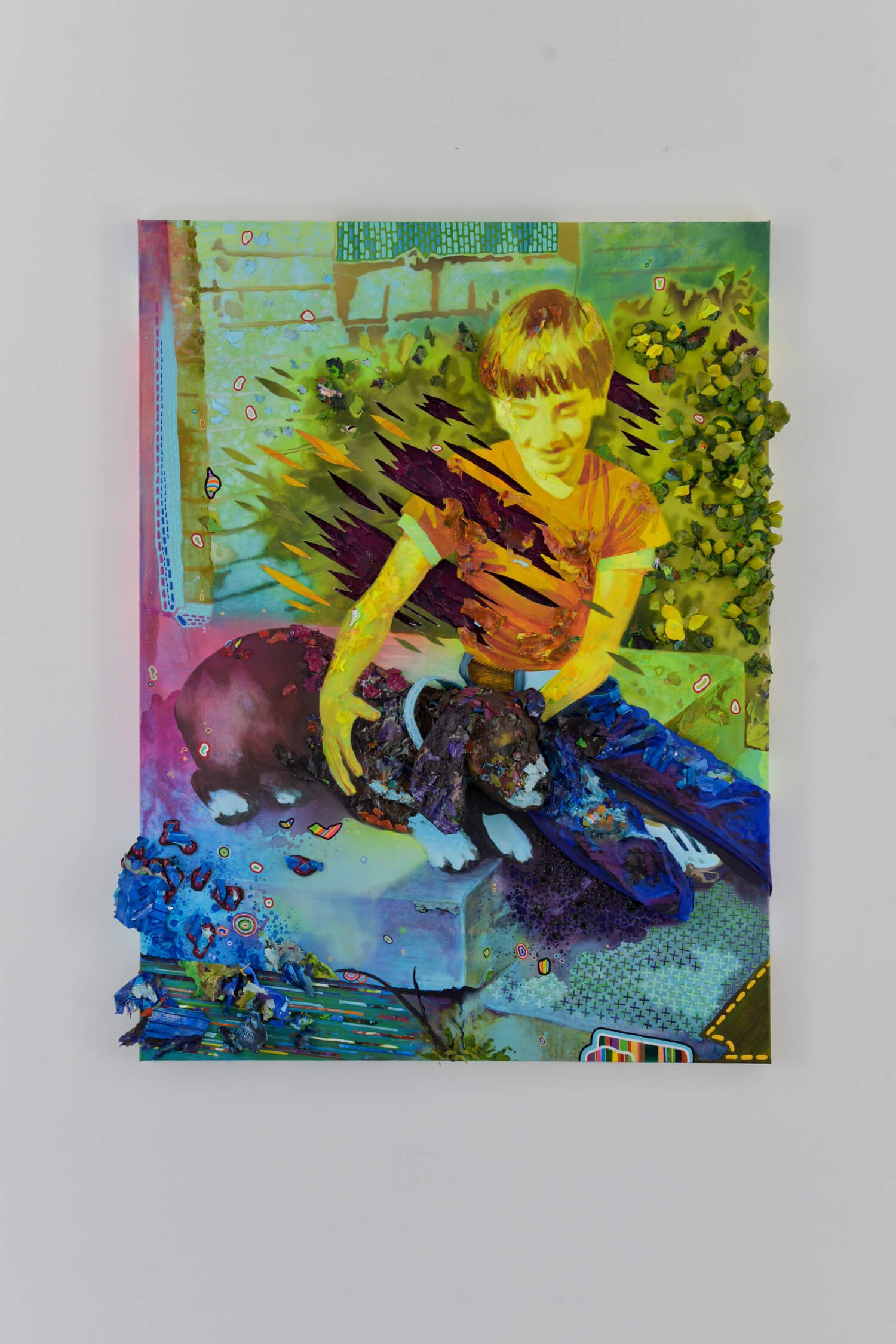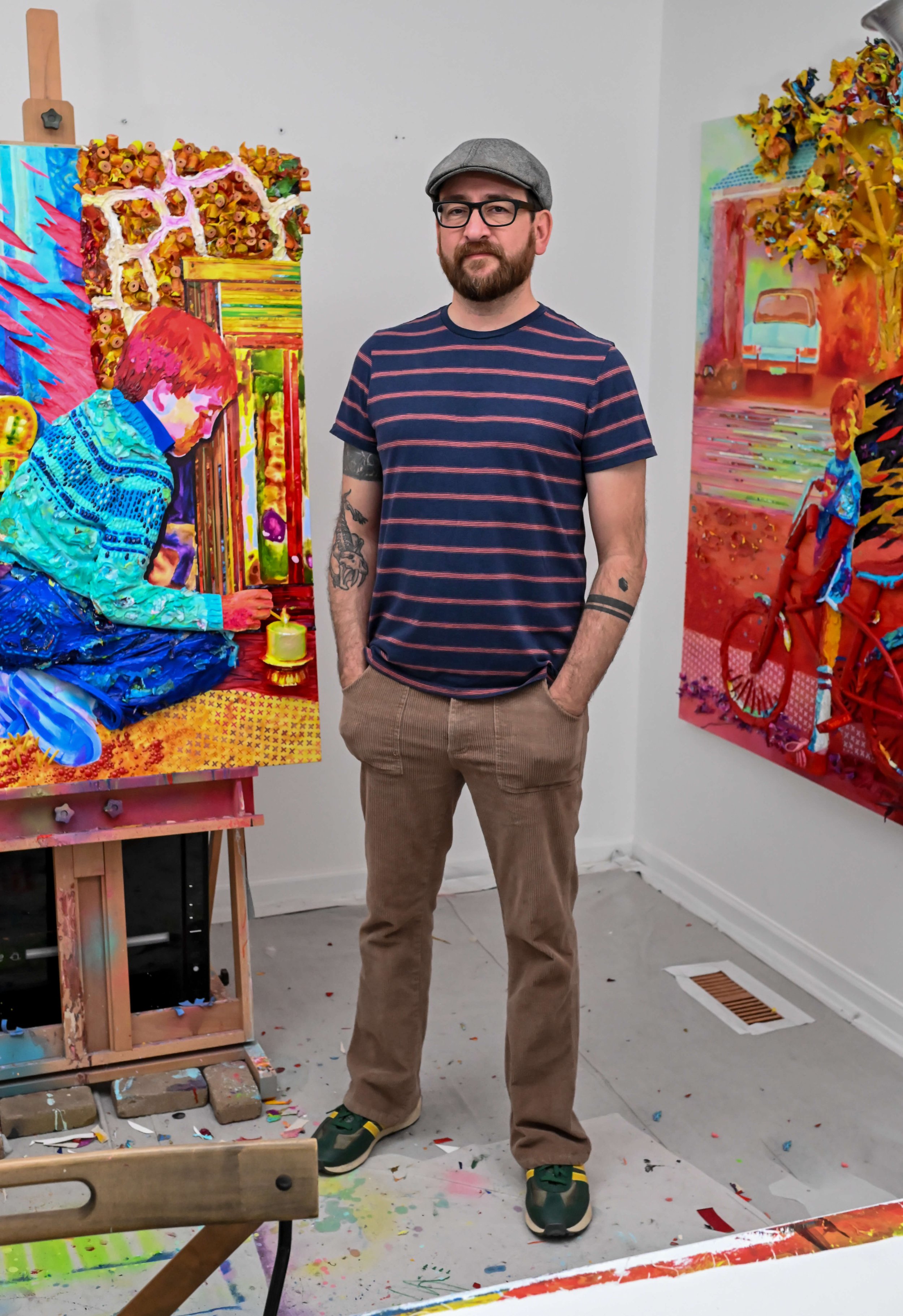Jason Shelby Schuler
My art serves as a visceral exploration of the relationship between trauma and healing, a journey rooted in my personal experience with childhood trauma and c-PTSD. This body of work represents the interplay between the mind and body in their capacity to mend and adapt. The techniques I employ with paint and canvas embody a post-trauma liminal experience, straddling the past, present, and future while blurring the boundaries of painting, sculpture, collage, and drawing. It achieves this by taking on forms reminiscent of the body's own healing processes—paint scabs peeled from the mixing palette, paint blisters formed from puffy paint, and other painterly references to bodily elements such as tears, scars, cuts, guts, and blood. All this occurs while a toxic color palette elicits a state of hyperarousal and hypervigilance, akin to the aftermath of trauma.
In some of the work, triggering childhood photographs are referenced, revealing the unsettling presence of flashbacks from past violence and abuse. As viewers engage with my art, they become implicated bystanders, experiencing discomfort in passive observation.
Ultimately, my art represents the process of taking trauma and channeling creativity to rise above the triggers and scars, transforming them into a message of hope and resilience. My mission as an artist extends beyond the canvas; I aspire to reshape societal understanding of trauma and mental health, solidifying an accurate trauma lens through which art can be viewed. Through my work, I aim to dismantle the stifling stigma surrounding these issues, fostering open dialogues that are often silenced, distorted, or marginalized. The paint and canvas are a testament to the resilience of the human spirit, an invitation to engage with the profound interplay of trauma and recovery, and an opportunity to challenge preconceived notions about these deeply impactful topics.
www.instagram.com/jasonshelbyschuler
How has the environment you grew up in affected your art practice?
The source material for my work is inspired directly by photos taken from my childhood, a period during which I lived in a very unsafe and traumatic environment. These traditional childhood photos reflect how nostalgic narratives can be deceptive. We approach a childhood photograph with a certain narrative in mind based on what is captured in the frame. My paintings make the invisible traumas carried by someone more visible through my artistic choices, processes, and techniques. It's in this vulnerability that the unseen courage faced by my younger self can be celebrated, and the traumatic experiences can be honored.
If your artwork was a mirror, what would it reflect?
My work exists as a reflection of the unseen nature of healing from trauma. It captures the psychological labor, scars, and visceral experiences. Millions of people carry their traumas silently out of fear of being misunderstood, ridiculed, discriminated against, or marginalized. Their burden goes unseen, and as a result, just existing requires a tremendous amount of effort. I aspire to use my work so that other survivors may feel seen and know they are not alone.
What is the most difficult part (or your least favorite part) of your process?
One of the most important rules I have for myself as an artist is that if I have an idea that scares me, I have to pursue it. For instance, when contemplating how to represent the concept of trauma, I asked myself what the worst and most damaging thing I could do to a painting would be. I immediately thought of cutting the canvas with a razor. This terrified me—how could I possibly recover a painting from such an act? It was in this moment I realized the healing power of facing fear and capturing this in my artistic practice. This intent not only pushes me as an artist, but also reflects the courage needed to face past traumas in order to heal.
Pursuing ‘artist’ as a career is not for the faint of heart. What is the most rewarding aspect of this pursuit?
Being an artist and trying to make a career out of it is often discouraged in our culture. It seems like a crazy idea to pursue art as a profession. For me, it's more of a calling. I've always been an artist; from a very young age, I was always making something—drawing, crafting, constructing things from recycled materials, painting, designing, doodling, etc. As an adult, I see it as a call to action—a tool for positive social change. The idea that I can use the things I create to possibly make a better world for others is both rewarding and humbling.
If your art is in a lineage of artists working within similar veins, who would be part of your lineage and why?
Unveiling the hidden psychological world of being human has a long history in art. Unfortunately, we are only now beginning to understand the science behind trauma and its impact on the brain and body. The artists who have influenced me in this vein include Tracy Emin, Anselm Kiefer, Louise Bourgeois, Edvard Munch, Vincent van Gogh, Jennifer Packer, Marlene Dumas, Mark Bradford, Ellen Gallagher, and Claire Tabouret, to name just a few. All of these artists inspire me to approach the notion of paint and canvas more inventively while embedding the personal psychological experience of being human in their work in a courageous way.







